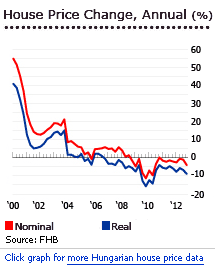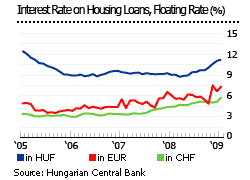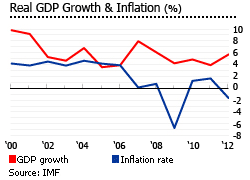Hungary: old flats suffer catastrophic price falls, as buyers shift to new

Hungary’s housing market is still depressed, after four years of house price falls. The nationwide house price index dropped by 2.2% in 2012 (-7.4% inflation-adjusted), according to the FHB Bank.
Second-hand dwelling prices fell 10.2% in 2012 (-14.8% inflation-adjusted), the biggest decline since Q4 2010, according to the Hungarian Central Statistical Office (KSH).
In contrast, the primary housing market showed remarkable improvement, with new dwelling prices rising 7.4% in 2012 (1.9% inflation-adjusted), the first year-on-year increase since Q2 2009.
Yet despite that surprising rise, Hungary’s housing market is still extremely weak. During Hungary’s housing boom (1998-2007), house prices soared by 264% (102% inflation-adjusted). However, the market started to fall in 2008, mainly due to the global financial meltdown. House prices dropped sharply. Demand waned, and construction activity started to fall.
- In 2008, house prices fell by 1.7% (-5.7% inflation-adjusted) y-o-y
- In 2009, house prices fell 11.34% (-15.73% inflation adjusted)
- In 2010, house prices rose by a meagre 0.11% (-4.06% inflation-adjusted)
- In 2011, house prices fell 2.12% (-5.94% inflation-adjusted)
Construction remains very weak in 2013. Residential permits plunged 36.6% to just 493 in the first two months, compared to the same period last year. In 2012 the number of new residential building permits issued dropped 12%, to 6,099. The number of dwellings built also fell 16.6% to 10,560.
In 2013, the economy continues to struggle. It contracted by 1.7% in 2012, from real GDP growth rates of 1.7% in 2011 and 1.2% in 2010. In 2013, economic growth is expected to be subdued, mainly due to the weak business environment, poor investment climate, and low labour participation, according to the IMF.
The Swiss franc boom ends

Despite the drop in housing loan subsidies, Hungary’s mortgage market grew strongly, from HUF 1.6 billion in 2003, to HUF4.09 billion in 2008, sustained, from 2004, by the entry of foreign-owned banks, and Swiss franc (CHF) denominated loans.
Swiss franc-denominated housing loans rose from HUF 124 billion in 2004, to HUF2.33 billion in 2008. The Swiss franc share of outstanding housing loans rose from 6% in 2004, to 57% in 2008.

In 2006, the average interest rate for a floating CHF housing loan was 3.29% while the rate for a similar type mortgage was 9.13% for a HUF loan, and 4.3% for a euro-loan.
Then in October 2008 it ended. Swiss franc housing loans have been withdrawn. The value of foreign denominated housing loans, as measured in their original currency, has dropped.
Construction has slowed

Construction has declined significantly, since the subsidy reductions, with permits down from a peak level of 59,241 dwellings in 2003, to an average of 44,300 dwellings from 2006 to 2008.
This was in contrast to early 2000, which saw a substantial increase in dwellings completed, from less than 25,000 annually (1998 to 2000), to 43,913 units in 2004, and 41,084 units in 2005, according to the Hungarian Central Statistics Office (CSO).
Budapest has been most severely affected by the recent slowdown, with construction volumes dropping by about 25% in 2008, from a year earlier.
A shift to Euro-denominated loans may somewhat save the housing market, as they have similar conditions and risk premiums to Swiss franc loans, but lower interest rates. But the net effect of the disappearance of Swiss franc loans will likely be to weaken the the mortgage market.
Foreign demand
Foreign demand for real estate in Budapest has greatly weakened. Demand from Spanish and Irish investors who account for up to 80% of total buyers, went down substantially reports Otthon Centrum, a real estate research firm. The number of transactions went down, the amount involved greatly reduced and the bargaining lengthened.
The first wave of post-opening foreigners bought in the 7th, 8th, and 9th Districts, which have a lot of historic charm. “Many foreigners bought investment apartments in 2001-2002,” says Andras Patkai of Budapestate.com.
“The foreigners bought in streets which often looked a mess, thinking these areas were beautiful but dirty,” says Patkai. “They imagined that the graffiti would be cleaned up and that they would look like Vienna. Well, the graffiti is still there and it doesn’t look like Vienna. It has taken much longer to clean these areas up than anyone imagined.”
“These were refurbished in a low quality, superficial way. This is no longer good enough!,” Patkai adds.
The supply of quality units is extremely limited to specific centres in the capital.
In July 2008, rental yields for Pest apartments averaged 5.6%, while Buda yields tailed slightly behind at 5.57%. Pest remains the city’s financial and commercial centre. Prices range from €82,240 on 40 sq.m. apartments, to €613,395 for 215 sq.m. apartments.
The Buda side of city is becoming a favorite of longer-term investors. With the market downturn, foreigners are tending to focus on university neighborhoods and high traffic areas, looking for used properties that can be refurbished.
Hungarian economy continues to struggle

From 1997 to 2006, Hungary enjoyed robust economic growth of about 4% per year. However, when the global credit crunch broke out, Hungary became particularly vulnerable mainly due to its high level of both private and state borrowing. Economic growth slowed sharply to 0.13% in 2007 and 0.74% in 2008. Then in 2009, real GDP shrank by 6.7%, the worst economic contraction since 1991.
In October 2008, the government was forced to ask the International Monetary Fund (IMF) and the European Central Bank (ECB) for a rescue package worth US$25 billion to restore financial stability and prevent the Hungarian economy from collapsing.
After the election of Prime Minister Viktor Orban in 2010, the new government nationalized US$13 billion worth of private pension-fund assets, and domestic banks were forced to convert their foreign-currency denominated mortgage loans to Hungarian forints.
The Hungarian economy returned to growth in 2010, with real GDP growth rates of 1.2% in 2010 and 1.7% in 2011. However, the economy contracted again by 1.7% in 2012, amidst high debt, high unemployment and the eurozone debt crisis.
In Q4 2012, the economy contracted for the fourth quarter in a row, with real GDP shrinking by 0.9% from the previous quarter, according to the Hungarian Central Statistical Office (KSH).
In 2013, economic growth is expected to be subdued, mainly due to weak business environment, poor investment climate, according to the IMF.
In 2012, Hungary’s general government deficit was about 2.5% of GDP. The deficit is expected to increase to 3.2% of GDP in 2013 and to 3.4% of GDP in 2014, according to the IMF.
The country’s gross public debt was about 79% of GDP last year and projected to rise to 79.9% of GDP in 2013 and 80.3% of GDP in 2014.
In the fourth quarter of 2012, the overall unemployment rate stood at 10.7%, up from 10.4% in the previous quarter, according to the KSH. Unemployment is projected to increase slightly to 11.1% this year, according to the IMF.
In an effort to buoy the struggling economy, the National Bank of Hungary (NBH), the country’s central bank unveiled the introduction of the program called “Funding for Growth Scheme”. This measure is aimed at increasing lending to businesses and reducing companies’ exposure to foreign currency denominated loans.
Under this program, commercial banks would get up to HUF250 billion (US$1.1 billion) in interest-free loans from the NBH while companies would get the same amount to convert their foreign currency denominated loans to forints. The program will be applied for three months starting June.
In addition, the NBH also plans to use €3 billion (US$3.82 billion) of its foreign currency reserves to help local banks cut their short-term currency debts.
In March 2013, the annual inflation rate fell to 2.2%, from 2.8% in the previous month and the lowest level since the country’s transition to a market economy. This sets the ground for more rate cuts to boost the economy.